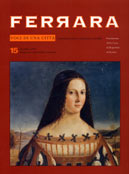Of course she could not love her husband, Giovanni Sforza, whom she had been forced to marry for reasons of state; she was not happy in Pesaro and Rome was often in her thoughts. But as soon as the war was over, Lucrezia returned to the Roman house of Santa Maria del Portico.
So why did the sixteen-year-old Lucrezia flee the gilded papal court where she was queen for the convent? What unpleasantness did she hope to avoid? The accusation of incest was made by Giovanni Sforza during negotiations for the divorce, wanted by the Pope in order to overturn existing alliances and which Giovanni refused.
There was only one way to obtain the divorce - by appealing to the old law under which a marriage could be annulled if not consummated within three years. Lucrezia declared that she had lived for three years "without carnal intercourse". Then the rumour began to circulate in Rome: the Pope had taken away Giovanni's wife because he wanted her to submit to his own desires.
But, to try to understand, let us return to the story of San Sisto. Lucrezia had forbidden anyone to visit her there, and the only outside news reached her through the Papal messengers, one of whom, Pedro Caldès or Perotto, brought her private messages, which accustomed Lucrezia to his daily presence.
The Spaniard Perotto was a handsome youth of twenty-two; the chronicles suggest that a relationship between the two followed. Fortunately it was a cold day when the pope's daughter appeared at the Vatican to hear the judgement that pronounced her intact and freed from her marriage ties: her pregnancy was well hidden by her winter clothes. Three months later she gave birth. Perotto paid with his life.
But the Pope was aiming high was his beloved daughter, and this time reasons of state and the heart coincided. Like Lucrezia, Alfonso of Aragon, Duke of Biscay and the natural son of the King of Naples, was just eighteen. They were attracted to each other at first sight, and spent pleasant days in each other's company. But there were clouds on the horizon.
This was the time of the Borgia terror: the Tiber was poisoned with the bodies of people who knew too much, obstacles to Cesare Borgia's lust for power and Alfonso of Aragon, mortally wounded in an ambush, was among the victims. Lucrezia knew who lay behind his murder, and realised that she should build her life elsewhere. She became aware that her father and brother, already planning another wedding, should have no future place in her life.
Lucrezia had already met Alfonso d'Este during a ceremony in the Vatican, but she had no recollection of him. And in any case, feelings had little to do with this marriage, which in fact represented a major financial transaction. Duke Ercole needed to fill the State coffers, and although this woman brought with her two children, one with an unknown father, she also brought a rich dowry of goods and other advantages.
There followed a succession of legendary events. The Duke stage-managed Lucrezia's ostentatious journey from Rome to Ferrara. The populace cheered along the route. By the time of Lucrezia's stay at the Corpus Domini convent the tumultuous welcome was over, but she was unable to banish her sadness at having left all she held dear - her father and children - behind in Rome. When she left the convent on 23 October she had no idea that fresh adventures awaited her.
A guest one evening of Ercole Strozzi at his villa in Ostellato, she was introduced to Pietro Bembo. They spoke of Petrarch and platonic love, and Bembo was entranced. The palazzo on via Capo delle Volte may have been the venue for lovers' meetings. However, Lucrezia's time was not completely taken up with love in Ferrara, since in Alfonso's absence she acted as regent.
But the exercise of power did not satisfy Lucrezia; she was in love with love, she needed a dream in which she could escape. This time the object of her love was her brother-in-law Francesco Gonzaga; Ercole Strozzi played Cupid. Knowing themselves to be surrounded by spies, they adopted false names; Strozzi was Zilio, Lucrezia, Barbara, and Francesco, Guido.
This intrigue came to an abrupt end when Strozzi was found dead at dawn on 6 June 1508, with twenty-two stab wounds on his body. The perpetrator was never discovered. After this Lucrezia's relationship with Francesco Gonzaga became a strictly Platonic affair, as befitted this woman who lived on the edge between the sacred and profane.



